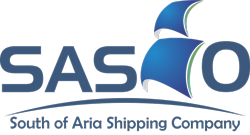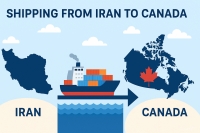Transportation Options from Iran to Canada
Shipping from Iran to Canada involves various methods, each tailored to factors like shipment volume, urgency, and budget. However, due to ongoing Canadian sanctions on Iran—related to nuclear activities—certain goods may face restrictions, requiring compliance with export controls and customs regulations. It's advisable to consult one of the best freight forwarders in Iran familiar with these rules to avoid delays.
Here are the primary options:
- Air Freight to Canada: The quickest method, ideal for time-sensitive or high-value items. Transit times typically range from 1-5 days, depending on the carrier (e.g., via international hubs like Dubai or Istanbul) (freightos). Costs average $3-$7 per kilogram, influenced by fuel surcharges and volume. Services must comply with Canada's Pre-load Air Cargo Targeting (PACT) program for security screening.
- Sea Freight A cost-effective choice for bulk or heavy shipments, using Less-than-Container Load (LCL) for smaller volumes or Full Container Load (FCL) for larger ones. Transit times can span 6 to 10 weeks, routing through ports like Bandar Abbas in Iran to Vancouver or Montreal in Canada (logisticiran). In sea freight shipping from Iran to Canada, rates are generally lower than air freight, often ranging from $50 to $150 per cubic meter for LCL shipments.
- Door-to-Door Services This integrated option combines air or sea transport with pickup from the origin and delivery to the destination in Canada, handling customs and logistics end-to-end. It's convenient for novices, with total times varying by base method (e.g., 3-7 days for air-based). Costs include additional fees for handling, typically 10-20% above standard freight rates.
Selecting the Optimal Method
Choose routes for shipping from Iran to Canada based on your needs: air for speed, sea for economy, and door-to-door for simplicity. Use online calculators for precise quotes, and always verify sanctions compliance to prevent issues like asset freezes or shipment hold.
|
Method |
Estimated Time |
Approximate Cost |
Best For |
|
Air Freight |
1–5 days |
$2.50–$5 per kg |
Urgent, high-value goods |
|
Sea Freight |
20–40 days |
$50–$150 per m³ |
Bulk shipments |
|
Door-to-Door |
Varies 3–45 days |
+10–20% on base cost |
Convenience-focused |
Cost Factors in Sea Freight from Iran to Canada
When considering shipping from Iran to Canada, sea freight is often the most cost-effective option for large shipments. However, several factors influence the final cost:
- Shipment Volume and Weight – Larger shipments or full container loads (FCL) generally reduce the per-unit cost compared to smaller LCL shipments.
- Distance and Route – The specific ports used and the route taken can affect transit time and shipping charges.
- Packaging and Handling – Proper packaging ensures goods are protected during long sea journeys, but specialized packaging may increase costs.
- Customs and Documentation – Accurate and complete documentation is required to avoid delays or fines, which can add to the total cost.
- Additional Services – Door-to-door delivery, insurance, and expedited handling will also influence the final shipping price.
Understanding these factors helps businesses and individuals plan and budget effectively, ensuring a smooth and economical shipping process from Iran to Canada.
Required Documentation for Shipping
Shipping from Iran to canada requires meticulous preparation of documentation to comply with both countries' customs regulations, which are influenced by international sanctions. Proper paperwork is essential to avoid delays, seizures, or penalties at ports of entry like Vancouver or Toronto. Always verify with a licensed customs broker or freight forwarder, as requirements can vary by shipment type (commercial vs. personal) and goods category. Key documents for shipping from Iran to canada typically include:
- Commercial Invoice (or Canada Customs Invoice) This detailed document, required for all commercial shipments, outlines the transaction between buyer and seller, including a full description of goods, quantity, value, Harmonized System (HS) codes, country of origin, and terms of sale. It must be in English or French and is used by the Canada Border Services Agency (CBSA) for valuation, duties, and taxes.
- Bill of Lading (B/L) or Air Waybill (AWB) Issued by the carrier, this serves as a receipt for the goods, a contract of carriage, and proof of title. For sea freight, it's a B/L; for air, an AWB. It details the type, quantity, weight, and destination of the shipment, and is crucial for customs release in Canada.
- Packing List An itemized inventory of the shipment's contents, including descriptions, quantities, weights, dimensions, and packaging details.
- Export/Import Permits or Licenses (if applicable) Due to sanctions, certain goods require an export license from Iran's Ministry of Industry, Mine and Trade, or an import permit from Canada's Global Affairs for items not fully prohibited.
- Other Supporting Documents
- Insurance Certificate: Proof of cargo insurance, recommended for high-value shipments.
- Shipper's Export Declaration (SED): Required for Iranian exports to track controlled goods.
Tips to Minimize Costs and Avoid Delays
To reduce costs and prevent delays when shipping from Iran to Canada, follow these tips:
- Choose the Right Shipping Method: Sea freight is cost-effective for bulk shipments, while air freight is faster for urgent goods.
- Consolidate Shipments: Combining multiple shipments or optimizing packaging reduces volume- and weight-based fees.
- Ensure Accurate Documentation: Correct invoices, HS codes, and permits prevent customs delays and fines.
- Work with Experienced Freight Forwarders: Professionals familiar with Iran-Canada regulations streamline the process.
- Book in Advance and Track Shipments: Early booking and active tracking help avoid last-minute surcharges and unexpected delays.
- Use Cargo Insurance for High-Value Items: Protects against loss, damage, or theft during transit.
Canada's Top Imports in 2025
In 2026, Canada will remain one of the world's largest importers, with total imports valued at approximately CAD 62.7 billion in July alone, reflecting a diverse economy reliant on global supply chains for manufacturing, energy, and consumer needs. Below, we'll introduce the top imported goods in detail, highlighting their significance, key suppliers, and approximate values based on 2025 data (df-alliance).
- Vehicles (Cars, Trucks, and Auto Parts): Canada imports a wide range of vehicles and automotive components essential for domestic production, supporting manufacturers and growing demand for electric and hybrid models. Businesses interested in Shipping from Iran to Canada should ensure compliance with vehicle regulations.
- Machinery and Equipment: Includes industrial tools, construction machinery, and mechanical equipment for manufacturing and resource extraction, critical for sectors such as oil, mining, and construction.
- Electronics: Consumer devices, semiconductors, and IT hardware fuel Canada’s tech sector and household consumption, with high demand for advanced components.
- Mineral Fuels and Oil: Crude oil and refined products meet energy needs for transportation and heating, with Canada importing specific types required for refining.
- Plastics: Raw plastics, polymers, and resins supply packaging, automotive, and consumer goods, with increasing emphasis on recycled and sustainable materials.
- Pharmaceuticals: Medicines, vaccines, and medical supplies meet healthcare demands and an aging population’s needs.
- Electrical Machinery: Generators, transformers, and electrical components support infrastructure, manufacturing, and renewable energy projects.
- Chemicals and Fertilizers: Essential for agriculture and industry, contributing to food security and resource management.
- Iron and Steel Products: Sheets, bars, and alloys support construction and industrial applications.
- Textiles and Apparel: Fabrics and ready-made garments serve retail and fashion, and exporters considering Shipping from Iran to Canada must follow proper labeling and customs documentation.
For a quick overview, here's a summary table of these top imports:
|
Rank |
Product |
Value (Billion CAD) |
Main Suppliers |
|
1 |
Vehicles (cars, trucks, and parts) |
72 |
USA, Japan, Mexico |
|
2 |
Machinery and equipment |
45 |
USA, Germany, China |
|
3 |
Electronics |
38 |
China, USA, South Korea |
|
4 |
Mineral fuels and oil |
35 |
USA, Saudi Arabia |
|
5 |
Plastics |
15 |
USA, China, Germany |
|
6 |
Pharmaceuticals |
14 |
USA, Germany, Switzerland |
|
7 |
Electrical machinery |
12 |
USA, Japan, Germany |
|
8 |
Chemicals and fertilizers |
10 |
USA, China, Belgium |
|
9 |
Iron and steel products |
8 |
USA, China, South Korea |
|
10 |
Textiles and apparel |
6 |
China, Bangladesh, Vietnam |
Freight Forwarder Iran to Canada
Shipping goods from Iran to Canada requires a reliable freight forwarder to ensure smooth and timely delivery. Professional forwarding services handle customs clearance, documentation, and cargo management, whether by sea, air, or door-to-door. Proper planning reduces delays, prevents extra costs, and ensures compliance with regulations.
Partnering with an experienced provider like SASCO guarantees expert support throughout the shipping process. Contact SASCO today to get customized solutions and make your shipment from Iran to Canada efficient and hassle-free.







